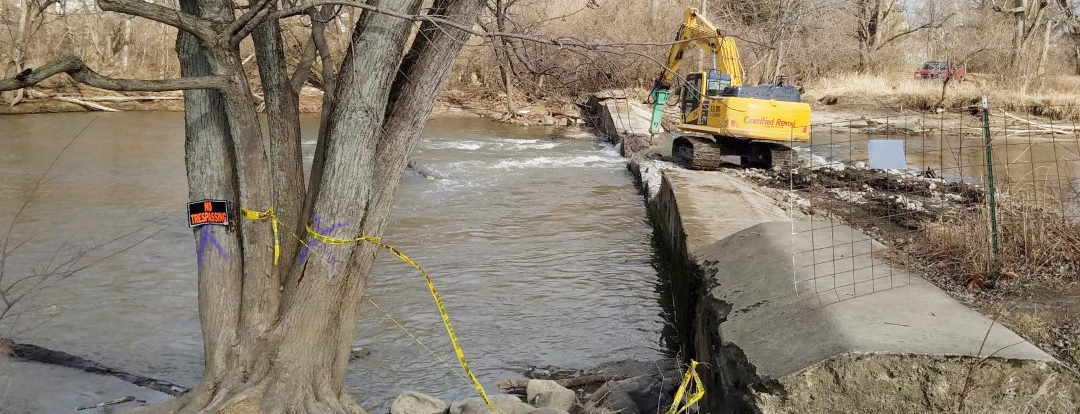Dams have caused considerable harm to the nation’s rivers: they deplete fisheries, degrade ecosystems, and are a danger to people. Today, many dams that were once the center of a community’s livelihood are now old, unsafe, and no longer serving their intended purposes.
Member Mary Bookwalter is funding a number of dam removals in her home state of Indiana both as an individual and through the Indiana Forest Alliance as a donor and volunteer. Most recently, she helped decommission the Collamer Dam on the Eel River. Mary spoke with us about how she got involved in these projects and what’s next.
Why is it important to remove dams?
There are over 600 low head dams in Indiana rivers and major creeks, most of them built between 1850 and the 1930s. They are hazards to human life, fish migrations, and freshwater mussels. They also increase sedimentation. Several people have died after falling in or kayaking over the dam. The water appears gentle, but it becomes a very dangerous force if you get caught in plunge pools which may be four times deeper than the dam height.
You helped decommission Collamer Dam in the Eel River. How did that come about?
My family farmed near this river in the 1850s and 60s and I’ve always cared about this place. I made a grant to Manchester University in 2014 so that Environmental Studies Professor Jerry Sweeten could hire interns and staff to help research the ecology and hydrology of these rivers and make the case for removal. He was able to marshal a great deal of expertise and support from the US Fish and Wildlife Services, Indiana DNR, and local conservation groups.
How has the dam removal helped the ecosystem there?
Removing the dam has opened 94 miles of the Eel River from the confluence with the Wabash River at Logansport, to its source just north of Fort Wayne. This is possible because Dr. Sweeten was able to design a special fish ladder at Stockton Gristmill Dam, the last remaining Eel River dam. Native species like smallmouth bass can now migrate freely along the length of the river. Over 80 percent of fish species in the Eel River migrate upstream and this dam was a huge barrier. The fish carry baby mussels in their gills, thereby repopulating the river with mussels as well. It’s naturally a cobble-bottom river and we’re already seeing the sediment clear out.
What river restoration projects are you working on now?
We’re now funding Dr. Sweeten’s work on other dam removal projects through the Indiana Forest Alliance.
The first is a dam at the confluence of the Eel River in Logansport. When that one comes out in the fall, it will conclude the largest dam removal project east of the Mississippi, to our knowledge.
The second project is on the Blue River in Southern Indiana near the town of Corydon, the original state capitol. Their dam came out last spring and we’re funding a scientific instrument that continuously tracks the health of the river. Logging is a real threat here, and we’re concerned about wildlife, particularly Hellbender salamanders.
What was the community’s response to the Collamer Dam’s removal?
Mother Nature actually caused a breach under the dam before we removed it last spring. And the “owner” was trying to fill it in before they got a serendipitous visit from the Fish and Wildlife Service. This shows that even though no one is using these dams for grist mills, hydropower, or water sources, Hoosiers are often opposed because they don’t want things to change.
For instance, there’s a dam in the town of Edinburgh, on yet another Blue River, that the town managers don’t want to remove even though three young people died there on their high school graduation day. Also, local governments and community leaders are reluctant to speak out. There were many state government people celebrating the removal of the Collamer Dam, but they didn’t want to be there in their official capacity.
What other environmental issues are you working on in Indiana?
Because Indiana is often considered “flyover country,” our issues here are far too easily overlooked. I’m working on setting up an organization that educates Hoosiers on environmental policy in our state. It will exist solely to comment on legislation, which is beholden to the timber, coal, farming, and real estate industries, among others.
The Indiana Forest Alliance has done advocacy work like this before. In 2015, then Governor Mike Pence was supporting a planned dam project on the White River that would threaten Mounds State Park and the 2500 year old Native American ceremonial mounds themselves, 60 businesses and 500 homes in the city of Anderson, and 7.5 miles of the river itself. The Indiana Forest Alliance canvassed towns along the river with support from the League of Women Voters, Citizens Action Coalition, and Heart of the River. In the end, we won and the project died. It would have been, according to economist Michael Hicks of Ball State University, “the largest urban inundation project in the Western Hemisphere.”
Although I often feel isolated doing this work, I’ve been inspired to continue by seeing the many women of Rachel’s Network who fund projects they share and care about so deeply.
Photo of Collamer Dam removal courtesy of Mary Bookwalter.



This is such good news! Really appreciate this inspiring restoration work. Well done Mary.